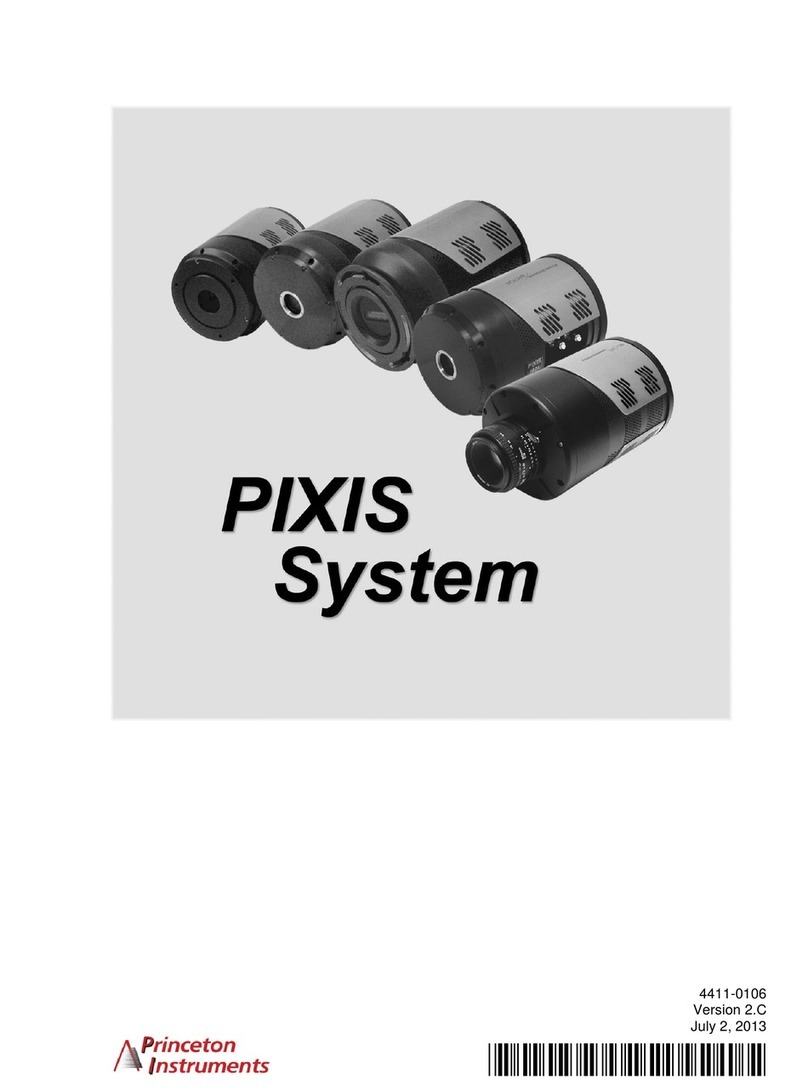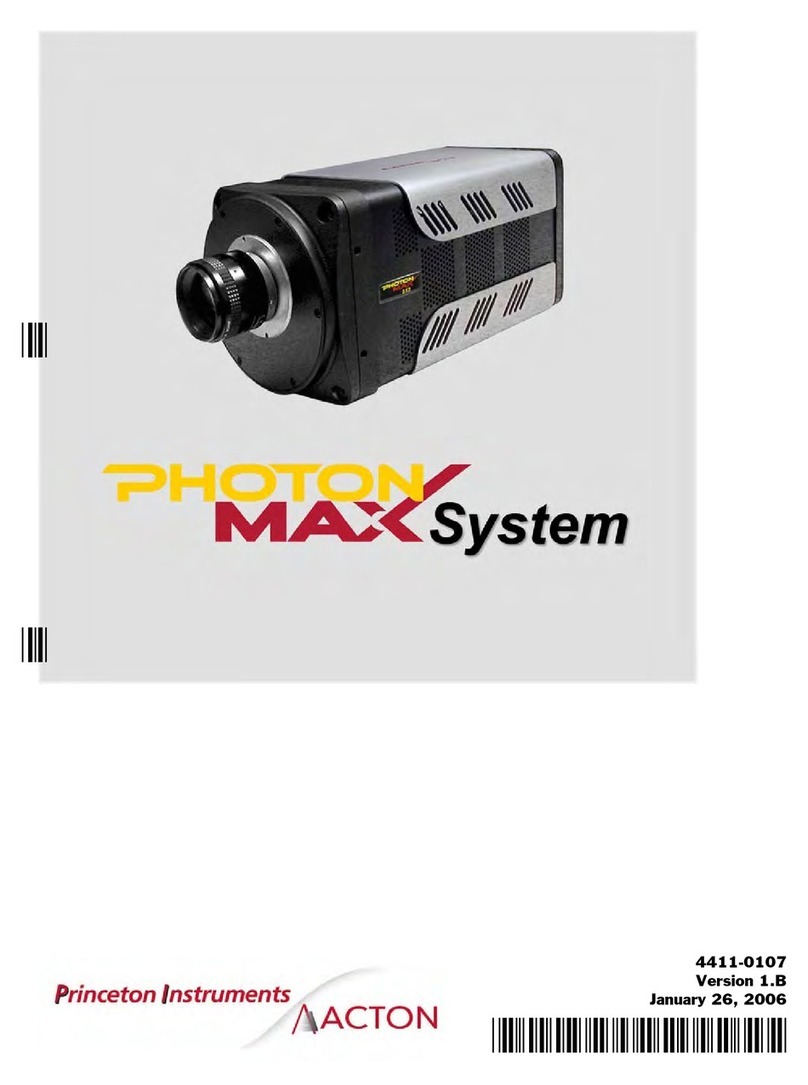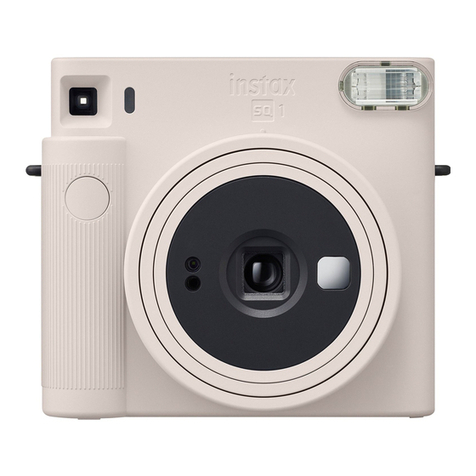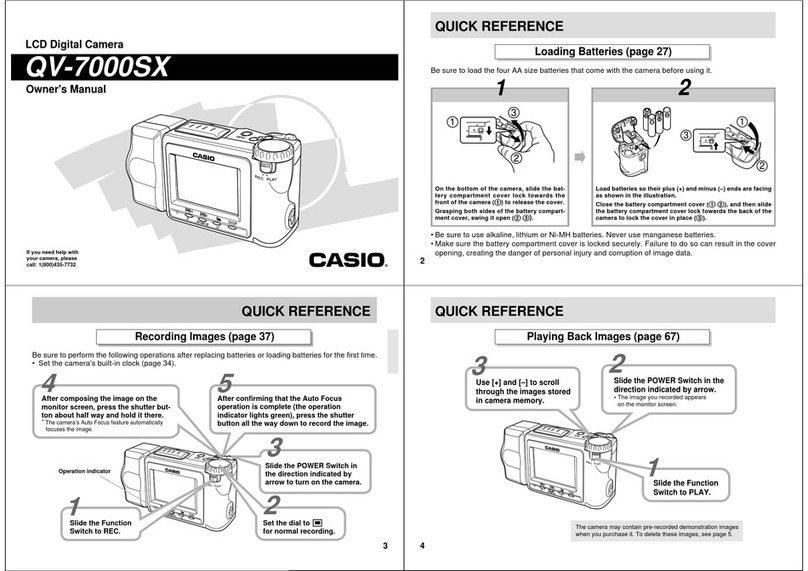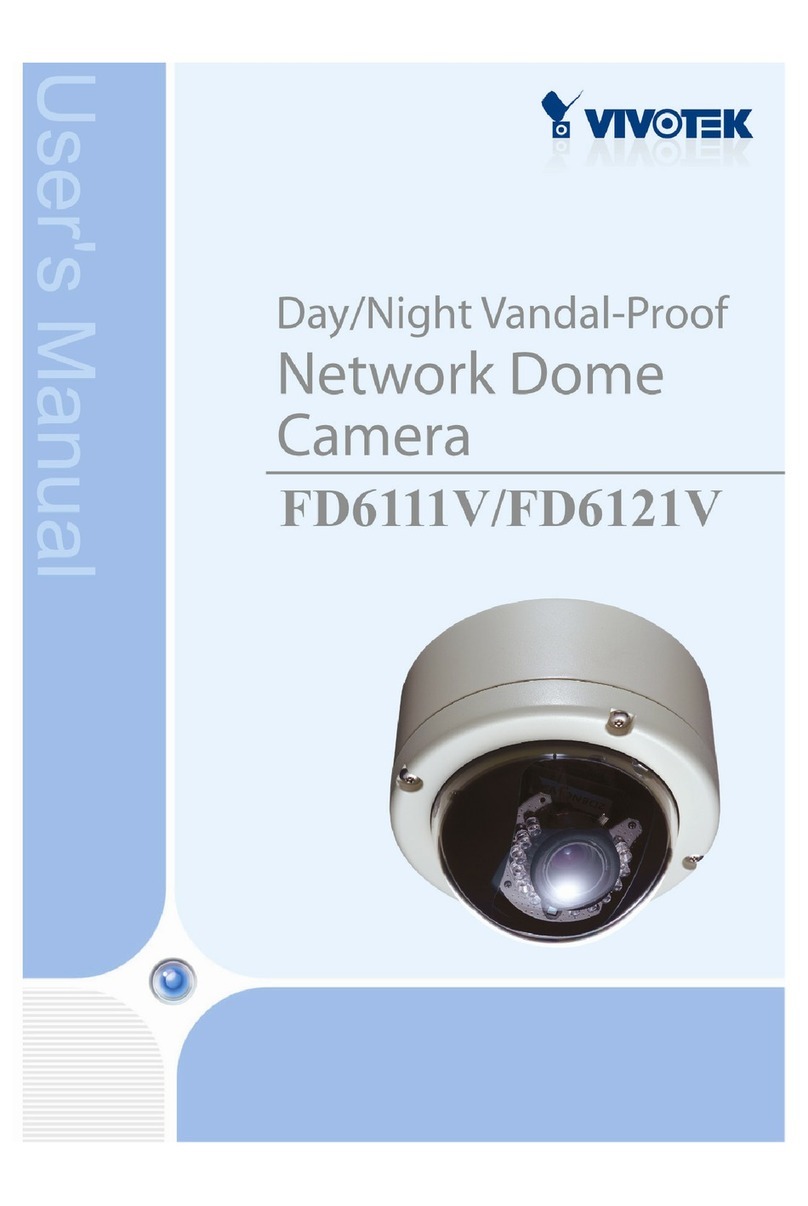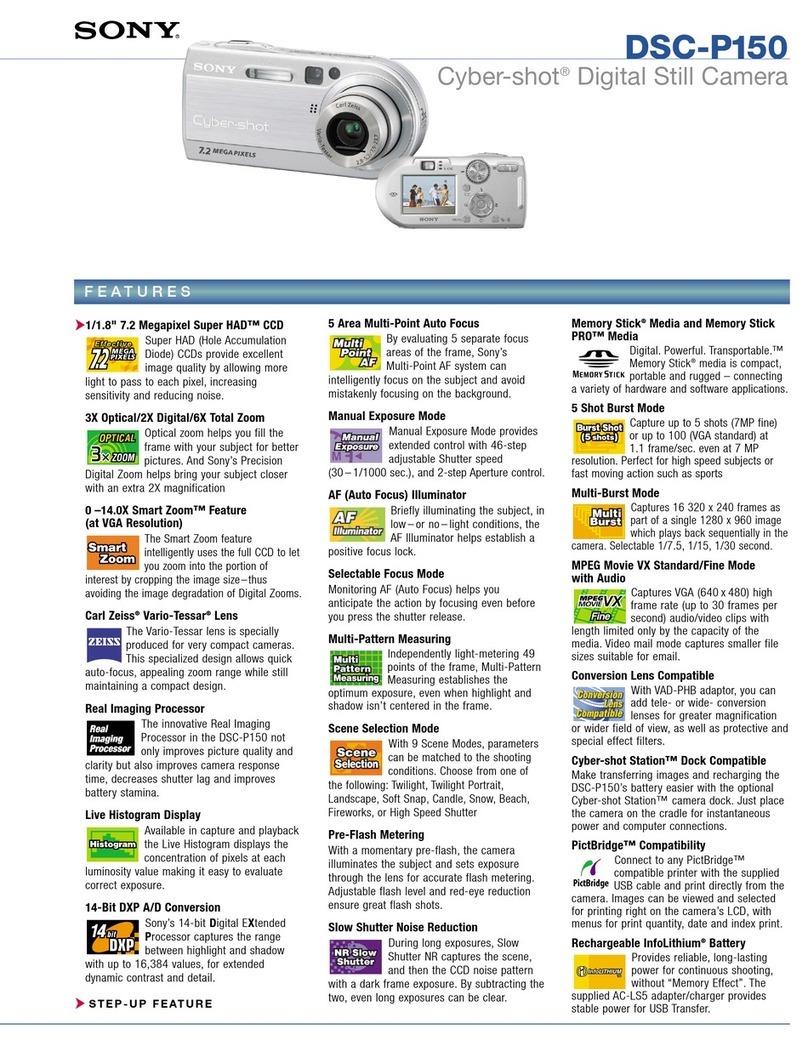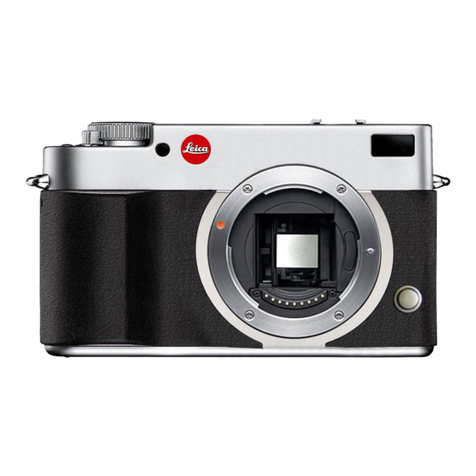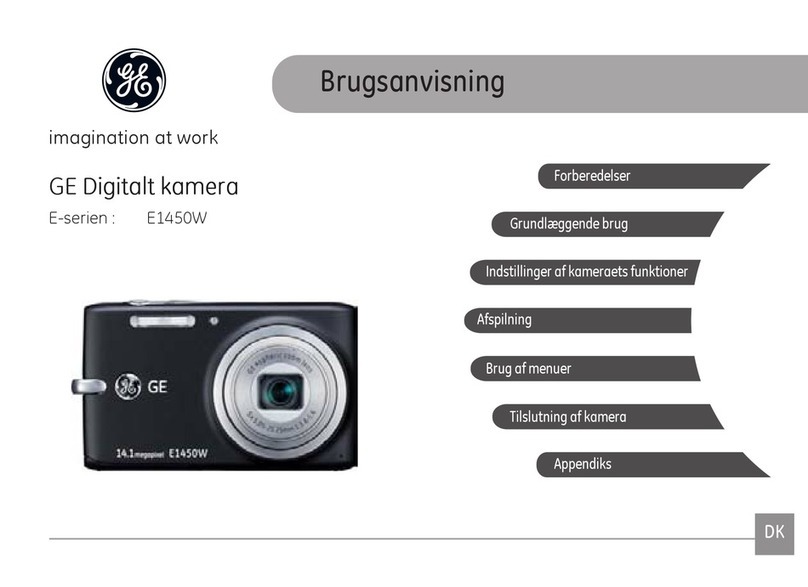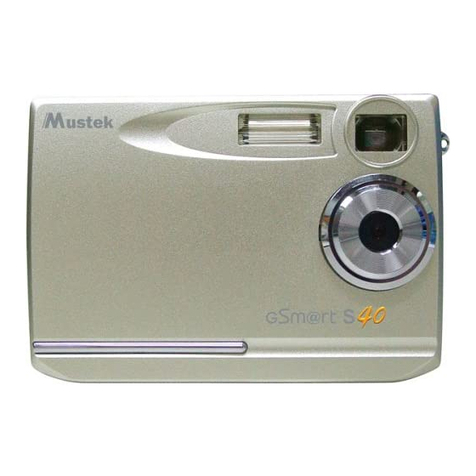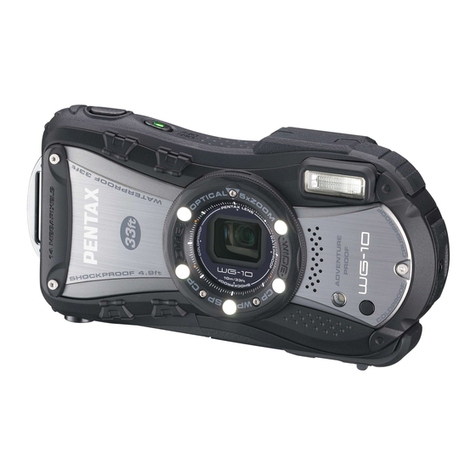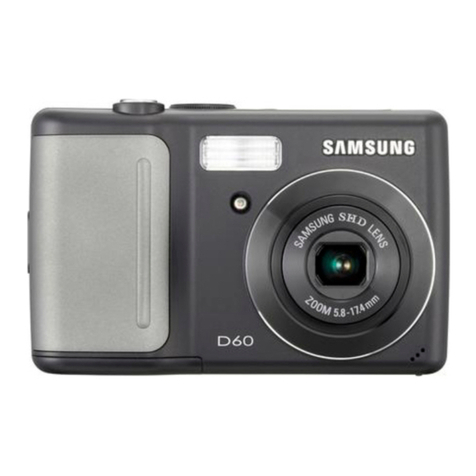Princeton Instruments NIRvana-LN User manual

NIRvana-LN™
Camera System
4411-0145
Issue 4
April 20, 2016

All rights reserved. No part of this publication may be reproduced by any means without the written permission of Princeton
Instruments, a division of Roper Scientific, Inc. (“Princeton Instruments”).
Printed in the United States of America.
Pentium is a registered trademark of Intel Corporation.
PVCAM is a registered trademark of Photometrics, Ltd. Corporation
Scientific Imaging ToolKit and SITK are trademarks of R Cubed Software Consultants, LLC.
IntelliCal, PICam, SuperSYNCHRO, and SyncMASTER are trademarks and IsoPlane, LightField, and PI-MAX are registered
trademarks of Roper Scientific, Inc.
Windows and Windows Vista are registered trademarks of Microsoft Corporation in the United States and/or other countries.
The information in this publication is believed to be accurate as of the publication release date. However, Princeton Instruments does
not assume any responsibility for any consequences including any damages resulting from the use thereof. The information contained
herein is subject to change without notice. Revision of this publication may be issued to incorporate such change.
Copyright 2015-2016 Princeton Instruments, a division of Roper Scientific, Inc.
3660 Quakerbridge Rd
Trenton, NJ 08619
TEL: 800-874-9789 / 609-587-9797
FAX: 609-587-1970
Revision History
Issue Date List of Changes
Issue 4 April 20, 2016 Issue 4 of this document incorporates the following changes:
•Removed the Declaration of Conformity.
Issue 3 September 17, 2015 Issue 3 of this document incorporates the following changes:
•Updated the Declaration of Conformity;
•Updated Figure B-2, Outline Drawing: NIRvana-LN with F-Mount, and Figure B-3,
Outline Drawing: NIRvana-LN with Spec-Mount, with newly released outline
drawings.
Issue 2 July 7, 2015 Issue 2 of this document incorporates the following changes:
•Expanded CAUTION on page 37 to include information about never powering
down the NIRvana-LN until all components have reached ambient temperature.
•Added CAUTION to Section 5.8, Shut Down Procedure, on page 48 about never
powering down the NIRvana-LN until all components have reached ambient
temperature.
•Added CAUTION to Section 6.10, Shut Down Procedure, on page 59 about never
powering down the NIRvana-LN until all components have reached ambient
temperature.
Issue 1 May 14, 2015 This is the initial release of this document

Table of Contents
Chapter 1: About this Manual . . . . . . . . . . . . . . . . . . . . . . . . . . . . . . . . . . . . . . 9
1.1 Intended Audience. . . . . . . . . . . . . . . . . . . . . . . . . . . . . . . . . . . . . . . . . . . . . . . . . . . . .9
1.2 Related Documentation . . . . . . . . . . . . . . . . . . . . . . . . . . . . . . . . . . . . . . . . . . . . . . . . .9
1.3 Document Organization . . . . . . . . . . . . . . . . . . . . . . . . . . . . . . . . . . . . . . . . . . . . . . .10
1.4 Conventions Used in this Manual . . . . . . . . . . . . . . . . . . . . . . . . . . . . . . . . . . . . . . . .11
1.5 Safety Related Symbols Used in this Manual . . . . . . . . . . . . . . . . . . . . . . . . . . . . . . .11
1.5.1 Grounding and Safety . . . . . . . . . . . . . . . . . . . . . . . . . . . . . . . . . . . . . . . . . . .12
1.6 Precautions . . . . . . . . . . . . . . . . . . . . . . . . . . . . . . . . . . . . . . . . . . . . . . . . . . . . . . . . .12
1.6.1 Detector . . . . . . . . . . . . . . . . . . . . . . . . . . . . . . . . . . . . . . . . . . . . . . . . . . . . . .13
1.6.2 Detector Window. . . . . . . . . . . . . . . . . . . . . . . . . . . . . . . . . . . . . . . . . . . . . . .13
1.6.3 External Shutter . . . . . . . . . . . . . . . . . . . . . . . . . . . . . . . . . . . . . . . . . . . . . . . .13
Chapter 2: NIRvana-LN Camera System . . . . . . . . . . . . . . . . . . . . . . . . . . . . . 15
2.1 NIRvana-LN Camera . . . . . . . . . . . . . . . . . . . . . . . . . . . . . . . . . . . . . . . . . . . . . . . . .16
2.1.1 InGaAs FPA Sensor. . . . . . . . . . . . . . . . . . . . . . . . . . . . . . . . . . . . . . . . . . . . .17
2.1.2 Dewar. . . . . . . . . . . . . . . . . . . . . . . . . . . . . . . . . . . . . . . . . . . . . . . . . . . . . . . .17
2.1.3 Window . . . . . . . . . . . . . . . . . . . . . . . . . . . . . . . . . . . . . . . . . . . . . . . . . . . . . .17
2.1.4 Rear-Panel Connectors . . . . . . . . . . . . . . . . . . . . . . . . . . . . . . . . . . . . . . . . . .17
2.1.5 Dewar. . . . . . . . . . . . . . . . . . . . . . . . . . . . . . . . . . . . . . . . . . . . . . . . . . . . . . . .18
2.2 Spectrometer Support . . . . . . . . . . . . . . . . . . . . . . . . . . . . . . . . . . . . . . . . . . . . . . . . .18
2.3 Power Supply . . . . . . . . . . . . . . . . . . . . . . . . . . . . . . . . . . . . . . . . . . . . . . . . . . . . . . .18
2.4 Standard Cables. . . . . . . . . . . . . . . . . . . . . . . . . . . . . . . . . . . . . . . . . . . . . . . . . . . . . .19
2.5 Certificate of Performance . . . . . . . . . . . . . . . . . . . . . . . . . . . . . . . . . . . . . . . . . . . . .19
2.6 NIRvana-LN System User Manual . . . . . . . . . . . . . . . . . . . . . . . . . . . . . . . . . . . . . . .19
2.7 Optional Accessories. . . . . . . . . . . . . . . . . . . . . . . . . . . . . . . . . . . . . . . . . . . . . . . . . .20
2.7.1 Application Software. . . . . . . . . . . . . . . . . . . . . . . . . . . . . . . . . . . . . . . . . . . .20
2.7.2 Optical Adapters . . . . . . . . . . . . . . . . . . . . . . . . . . . . . . . . . . . . . . . . . . . . . . .21
2.8 Care and Cleaning of a NIRvana-LN System . . . . . . . . . . . . . . . . . . . . . . . . . . . . . . .22
2.8.1 Camera. . . . . . . . . . . . . . . . . . . . . . . . . . . . . . . . . . . . . . . . . . . . . . . . . . . . . . .22
2.8.2 Optical Surfaces. . . . . . . . . . . . . . . . . . . . . . . . . . . . . . . . . . . . . . . . . . . . . . . .22
2.9 Repairs. . . . . . . . . . . . . . . . . . . . . . . . . . . . . . . . . . . . . . . . . . . . . . . . . . . . . . . . . . . . .22
Chapter 3: Installation Overview . . . . . . . . . . . . . . . . . . . . . . . . . . . . . . . . . . . 23
Chapter 4: System Setup . . . . . . . . . . . . . . . . . . . . . . . . . . . . . . . . . . . . . . . . . 27
4.1 Unpack the System . . . . . . . . . . . . . . . . . . . . . . . . . . . . . . . . . . . . . . . . . . . . . . . . . . .27
4.2 Check the Equipment and Parts Inventory . . . . . . . . . . . . . . . . . . . . . . . . . . . . . . . . .27
4.3 System Requirements . . . . . . . . . . . . . . . . . . . . . . . . . . . . . . . . . . . . . . . . . . . . . . . . .28
4.3.1 Ventilation . . . . . . . . . . . . . . . . . . . . . . . . . . . . . . . . . . . . . . . . . . . . . . . . . . . .28
4.3.2 Coolant . . . . . . . . . . . . . . . . . . . . . . . . . . . . . . . . . . . . . . . . . . . . . . . . . . . . . .28
4.3.3 Detector Power . . . . . . . . . . . . . . . . . . . . . . . . . . . . . . . . . . . . . . . . . . . . . . . .28
4.4 Host Computer Specifications. . . . . . . . . . . . . . . . . . . . . . . . . . . . . . . . . . . . . . . . . . .29
4.4.1 LightField Host Computer Requirements . . . . . . . . . . . . . . . . . . . . . . . . . . . .29
4.4.2 WinView/32 and WinSpec/32 Host Computer Requirements . . . . . . . . . . . .30

4NIRvana
™-LN System Manual Issue 4
4.5 Data Acquisition Software Installation . . . . . . . . . . . . . . . . . . . . . . . . . . . . . . . . . . . 31
4.5.1 Install LightField . . . . . . . . . . . . . . . . . . . . . . . . . . . . . . . . . . . . . . . . . . . . . . 31
4.5.2 Install WinSpec/32 . . . . . . . . . . . . . . . . . . . . . . . . . . . . . . . . . . . . . . . . . . . . . 32
4.6 Mounting to a Spectrograph. . . . . . . . . . . . . . . . . . . . . . . . . . . . . . . . . . . . . . . . . . . . 33
4.6.1 Focal Plane Distance . . . . . . . . . . . . . . . . . . . . . . . . . . . . . . . . . . . . . . . . . . . 33
4.6.2 Optical Center of the Array . . . . . . . . . . . . . . . . . . . . . . . . . . . . . . . . . . . . . . 34
4.6.3 Array Orientation . . . . . . . . . . . . . . . . . . . . . . . . . . . . . . . . . . . . . . . . . . . . . . 34
4.7 Using an External Shutter . . . . . . . . . . . . . . . . . . . . . . . . . . . . . . . . . . . . . . . . . . . . . 34
4.8 Configure Default Parameters in LightField . . . . . . . . . . . . . . . . . . . . . . . . . . . . . . . 35
4.9 Configure Default Parameters for WinView/32 and WinSpec/32. . . . . . . . . . . . . . . 35
4.10 Fill the Dewar . . . . . . . . . . . . . . . . . . . . . . . . . . . . . . . . . . . . . . . . . . . . . . . . . . . . . . 37
4.10.1 Fill Procedure. . . . . . . . . . . . . . . . . . . . . . . . . . . . . . . . . . . . . . . . . . . . . . . . . 38
Chapter 5: LightField First Light Procedure . . . . . . . . . . . . . . . . . . . . . . . . . . 41
5.1 Operation Overview. . . . . . . . . . . . . . . . . . . . . . . . . . . . . . . . . . . . . . . . . . . . . . . . . . 42
5.2 System Setup and Configuration . . . . . . . . . . . . . . . . . . . . . . . . . . . . . . . . . . . . . . . . 43
5.3 Configure Parameters. . . . . . . . . . . . . . . . . . . . . . . . . . . . . . . . . . . . . . . . . . . . . . . . . 44
5.4 Confirm System Setup . . . . . . . . . . . . . . . . . . . . . . . . . . . . . . . . . . . . . . . . . . . . . . . . 45
5.5 Rotational Alignment. . . . . . . . . . . . . . . . . . . . . . . . . . . . . . . . . . . . . . . . . . . . . . . . . 46
5.6 Focus the System . . . . . . . . . . . . . . . . . . . . . . . . . . . . . . . . . . . . . . . . . . . . . . . . . . . . 47
5.7 Data Collection . . . . . . . . . . . . . . . . . . . . . . . . . . . . . . . . . . . . . . . . . . . . . . . . . . . . . 48
5.8 Shut Down Procedure . . . . . . . . . . . . . . . . . . . . . . . . . . . . . . . . . . . . . . . . . . . . . . . . 48
Chapter 6: WinSpec/32 and WinView/32 First Light Procedure. . . . . . . . . . . 49
6.1 Operation Overview. . . . . . . . . . . . . . . . . . . . . . . . . . . . . . . . . . . . . . . . . . . . . . . . . . 50
6.2 Power On Sequencing . . . . . . . . . . . . . . . . . . . . . . . . . . . . . . . . . . . . . . . . . . . . . . . . 51
6.3 System Setup and Configuration . . . . . . . . . . . . . . . . . . . . . . . . . . . . . . . . . . . . . . . . 51
6.4 Configure NIRvana-LN Parameters . . . . . . . . . . . . . . . . . . . . . . . . . . . . . . . . . . . . . 52
6.5 Configure IsoPlane SCT-320 Parameters . . . . . . . . . . . . . . . . . . . . . . . . . . . . . . . . . 54
6.6 Verify Shutter Operation . . . . . . . . . . . . . . . . . . . . . . . . . . . . . . . . . . . . . . . . . . . . . . 55
6.7 Rotational Alignment. . . . . . . . . . . . . . . . . . . . . . . . . . . . . . . . . . . . . . . . . . . . . . . . . 56
6.8 Focus the System . . . . . . . . . . . . . . . . . . . . . . . . . . . . . . . . . . . . . . . . . . . . . . . . . . . . 57
6.9 Acquire Data . . . . . . . . . . . . . . . . . . . . . . . . . . . . . . . . . . . . . . . . . . . . . . . . . . . . . . . 58
6.10 Shut Down Procedure . . . . . . . . . . . . . . . . . . . . . . . . . . . . . . . . . . . . . . . . . . . . . . . . 59
Chapter 7: Exposure and Signal . . . . . . . . . . . . . . . . . . . . . . . . . . . . . . . . . . . . 61
7.1 Array Architecture . . . . . . . . . . . . . . . . . . . . . . . . . . . . . . . . . . . . . . . . . . . . . . . . . . . 61
7.2 Exposure Time. . . . . . . . . . . . . . . . . . . . . . . . . . . . . . . . . . . . . . . . . . . . . . . . . . . . . . 61
7.2.1 Exposure with External Shutter . . . . . . . . . . . . . . . . . . . . . . . . . . . . . . . . . . . 61
7.3 Noise Sources. . . . . . . . . . . . . . . . . . . . . . . . . . . . . . . . . . . . . . . . . . . . . . . . . . . . . . . 62
7.4 Cooling the Array . . . . . . . . . . . . . . . . . . . . . . . . . . . . . . . . . . . . . . . . . . . . . . . . . . . 63
7.4.1 Array Temperature Control . . . . . . . . . . . . . . . . . . . . . . . . . . . . . . . . . . . . . . 63
7.5 Background Subtraction. . . . . . . . . . . . . . . . . . . . . . . . . . . . . . . . . . . . . . . . . . . . . . . 64
7.6 Flatfield Correction . . . . . . . . . . . . . . . . . . . . . . . . . . . . . . . . . . . . . . . . . . . . . . . . . . 66
7.7 Remove Sensor Blemishes. . . . . . . . . . . . . . . . . . . . . . . . . . . . . . . . . . . . . . . . . . . . . 67
7.8 Dark Signal . . . . . . . . . . . . . . . . . . . . . . . . . . . . . . . . . . . . . . . . . . . . . . . . . . . . . . . . 67
7.9 Saturation . . . . . . . . . . . . . . . . . . . . . . . . . . . . . . . . . . . . . . . . . . . . . . . . . . . . . . . . . . 68
7.10 Readout . . . . . . . . . . . . . . . . . . . . . . . . . . . . . . . . . . . . . . . . . . . . . . . . . . . . . . . . . . . 68
7.10.1 Region of Interest (ROI) . . . . . . . . . . . . . . . . . . . . . . . . . . . . . . . . . . . . . . . . 68
7.10.2 Controller Gain {Analog Gain} . . . . . . . . . . . . . . . . . . . . . . . . . . . . . . . . . . . 68

Table of Contents 5
7.11 Digitization . . . . . . . . . . . . . . . . . . . . . . . . . . . . . . . . . . . . . . . . . . . . . . . . . . . . . . . . .69
7.11.1 Digitization Rate . . . . . . . . . . . . . . . . . . . . . . . . . . . . . . . . . . . . . . . . . . . . . . .69
7.11.2 ADC Offset (Baseline Offset) . . . . . . . . . . . . . . . . . . . . . . . . . . . . . . . . . . . . .69
7.12 Software Binning. . . . . . . . . . . . . . . . . . . . . . . . . . . . . . . . . . . . . . . . . . . . . . . . . . . . .70
Chapter 8: Experiment Synchronization . . . . . . . . . . . . . . . . . . . . . . . . . . . . . 71
8.1 Shutter Control Modes . . . . . . . . . . . . . . . . . . . . . . . . . . . . . . . . . . . . . . . . . . . . . . . .71
8.2 Timing {Trigger Response} Modes . . . . . . . . . . . . . . . . . . . . . . . . . . . . . . . . . . . . . .72
8.2.1 Free Run {No Response} . . . . . . . . . . . . . . . . . . . . . . . . . . . . . . . . . . . . . . . .73
8.2.2 External Sync {Readout Per Trigger} . . . . . . . . . . . . . . . . . . . . . . . . . . . . . . .73
8.2.3 Bulb Trigger {Expose During Trigger Pulse}. . . . . . . . . . . . . . . . . . . . . . . . .74
8.2.4 Trigger Start {Start On Single Trigger} . . . . . . . . . . . . . . . . . . . . . . . . . . . . .75
8.3 Fast Mode . . . . . . . . . . . . . . . . . . . . . . . . . . . . . . . . . . . . . . . . . . . . . . . . . . . . . . . . . .75
8.4 TTL OUT Control . . . . . . . . . . . . . . . . . . . . . . . . . . . . . . . . . . . . . . . . . . . . . . . . . . . .77
Chapter 9: Non-Destructive Readout . . . . . . . . . . . . . . . . . . . . . . . . . . . . . . . 79
9.1 Configuration. . . . . . . . . . . . . . . . . . . . . . . . . . . . . . . . . . . . . . . . . . . . . . . . . . . . . . . .79
9.1.1 Compatibility Restrictions. . . . . . . . . . . . . . . . . . . . . . . . . . . . . . . . . . . . . . . .80
9.2 Frame Tracking . . . . . . . . . . . . . . . . . . . . . . . . . . . . . . . . . . . . . . . . . . . . . . . . . . . . . .80
9.3 Monitoring Experiment Progress . . . . . . . . . . . . . . . . . . . . . . . . . . . . . . . . . . . . . . . .82
9.4 Other Derived Parameters . . . . . . . . . . . . . . . . . . . . . . . . . . . . . . . . . . . . . . . . . . . . . .83
Chapter 10: Troubleshooting . . . . . . . . . . . . . . . . . . . . . . . . . . . . . . . . . . . . . . . 85
10.1 Baseline Signal Suddenly Changes . . . . . . . . . . . . . . . . . . . . . . . . . . . . . . . . . . . . . . .85
10.2 Camera1 (or Similarly Named Device) in Camera Name Field . . . . . . . . . . . . . . . . .86
10.3 Cooling Troubleshooting. . . . . . . . . . . . . . . . . . . . . . . . . . . . . . . . . . . . . . . . . . . . . . .88
10.3.1 Temperature Lock cannot be Achieved or Maintained. . . . . . . . . . . . . . . . . .88
10.3.2 Detector loses Temperature Lock . . . . . . . . . . . . . . . . . . . . . . . . . . . . . . . . . .88
10.3.3 Gradual Deterioration of Cooling Capability . . . . . . . . . . . . . . . . . . . . . . . . .88
10.4 Data Overrun Due to Hardware Conflict Message Displayed . . . . . . . . . . . . . . . . . .89
10.5 Detector Stops Working . . . . . . . . . . . . . . . . . . . . . . . . . . . . . . . . . . . . . . . . . . . . . . .89
10.6 Ethernet Network is Not Accessible . . . . . . . . . . . . . . . . . . . . . . . . . . . . . . . . . . . . . .90
10.6.1 WinSpec/32 Applications . . . . . . . . . . . . . . . . . . . . . . . . . . . . . . . . . . . . . . . .90
10.6.2 LightField Applications. . . . . . . . . . . . . . . . . . . . . . . . . . . . . . . . . . . . . . . . . .91
10.7 Program Error Message Displayed . . . . . . . . . . . . . . . . . . . . . . . . . . . . . . . . . . . . . . .92
10.8 Serial Violations Have Occurred. Check Interface Cable. . . . . . . . . . . . . . . . . . . . . .93
10.9 Vignetting . . . . . . . . . . . . . . . . . . . . . . . . . . . . . . . . . . . . . . . . . . . . . . . . . . . . . . . . . .93
Appendix A: Specifications . . . . . . . . . . . . . . . . . . . . . . . . . . . . . . . . . . . . . . . . . 95
A.1 Mechanical Dimensions . . . . . . . . . . . . . . . . . . . . . . . . . . . . . . . . . . . . . . . . . . . . . . .95
A.2 Power Specifications . . . . . . . . . . . . . . . . . . . . . . . . . . . . . . . . . . . . . . . . . . . . . . . . . .95
A.3 Environmental Specifications . . . . . . . . . . . . . . . . . . . . . . . . . . . . . . . . . . . . . . . . . . .96
A.4 Focal Plane Array Specifications . . . . . . . . . . . . . . . . . . . . . . . . . . . . . . . . . . . . . . . .96
A.5 AUX I/O Interface. . . . . . . . . . . . . . . . . . . . . . . . . . . . . . . . . . . . . . . . . . . . . . . . . . . .97
A.5.1 AUX I/O Cable . . . . . . . . . . . . . . . . . . . . . . . . . . . . . . . . . . . . . . . . . . . . . . . .99
Appendix B: Outline Drawings . . . . . . . . . . . . . . . . . . . . . . . . . . . . . . . . . . . . . 101
B.1 Power Supply . . . . . . . . . . . . . . . . . . . . . . . . . . . . . . . . . . . . . . . . . . . . . . . . . . . . . .101
B.2 NIRvana-LN . . . . . . . . . . . . . . . . . . . . . . . . . . . . . . . . . . . . . . . . . . . . . . . . . . . . . . .102

6NIRvana
™-LN System Manual Issue 4
Appendix C: IsoPlane 320 Mounting . . . . . . . . . . . . . . . . . . . . . . . . . . . . . . . . . 105
C.1 Required Items. . . . . . . . . . . . . . . . . . . . . . . . . . . . . . . . . . . . . . . . . . . . . . . . . . . . . 105
C.2 Replace F-Mount Adapter . . . . . . . . . . . . . . . . . . . . . . . . . . . . . . . . . . . . . . . . . . . . 106
C.3 Remove Camera Mounting Plate and Cover from IsoPlane 320. . . . . . . . . . . . . . . 107
C.4 Mount the NIRvana-LN on the IsoPlane 320 . . . . . . . . . . . . . . . . . . . . . . . . . . . . . 108
Appendix D: WinX/LightField Cross Reference . . . . . . . . . . . . . . . . . . . . . . . . 111
D.1 WinX-to-LightField Terminology . . . . . . . . . . . . . . . . . . . . . . . . . . . . . . . . . . . . . . 111
D.2 LightField-to-WinX Terminology . . . . . . . . . . . . . . . . . . . . . . . . . . . . . . . . . . . . . . 113
Declaration of Conformity . . . . . . . . . . . . . . . . . . . . . . . . . . . . . . 115
Warranty and Service . . . . . . . . . . . . . . . . . . . . . . . . . . . . . . . . . . 117
Limited Warranty. . . . . . . . . . . . . . . . . . . . . . . . . . . . . . . . . . . . . . . . . . . . . . . . . . . 117
Basic Limited One (1) Year Warranty. . . . . . . . . . . . . . . . . . . . . . . . . . . . . 117
Limited One (1) Year Warranty on Refurbished or Discontinued Products 117
XP Vacuum Chamber Limited Lifetime Warranty . . . . . . . . . . . . . . . . . . . 117
Sealed Chamber Integrity Limited 12 Month Warranty . . . . . . . . . . . . . . . 118
Vacuum Integrity Limited 12 Month Warranty . . . . . . . . . . . . . . . . . . . . . . 118
Image Intensifier Detector Limited One Year Warranty . . . . . . . . . . . . . . . 118
X-Ray Detector Limited One Year Warranty . . . . . . . . . . . . . . . . . . . . . . . 118
Software Limited Warranty . . . . . . . . . . . . . . . . . . . . . . . . . . . . . . . . . . . . . 118
Owner's Manual and Troubleshooting . . . . . . . . . . . . . . . . . . . . . . . . . . . . . 119
Your Responsibility . . . . . . . . . . . . . . . . . . . . . . . . . . . . . . . . . . . . . . . . . . . 119
Contact Information. . . . . . . . . . . . . . . . . . . . . . . . . . . . . . . . . . . . . . . . . . . . . . . . . 120
List of Figures
Figure 2-1: NIRvana-LN Camera System: Standard Items . . . . . . . . . . . . . . . . . . . 15
Figure 2-2: Typical NIRvana-LN Camera . . . . . . . . . . . . . . . . . . . . . . . . . . . . . . . . 16
Figure 2-3: NIRvana-LN Rear-Panel Connectors. . . . . . . . . . . . . . . . . . . . . . . . . . . 17
Figure 2-4: Typical NIRvana-LN Power Supply . . . . . . . . . . . . . . . . . . . . . . . . . . . 18
Figure 3-1: System Diagram: NIRvana-LN Imaging Application . . . . . . . . . . . . . . 23
Figure 3-2: System Diagram: NIRvana-LN Spectrographic Application. . . . . . . . . 23
Figure 4-1: Typical LightField Installation Wizard Dialog . . . . . . . . . . . . . . . . . . . 31
Figure 4-2: WinSpec: Select Installation Type Dialog . . . . . . . . . . . . . . . . . . . . . . . 32
Figure 4-3: Entrance Slit Shutter Mount. . . . . . . . . . . . . . . . . . . . . . . . . . . . . . . . . . 34
Figure 4-4: Typical Camera Detection Wizard - Welcome Dialog . . . . . . . . . . . . . 36
Figure 4-5: Dewar Ports and Valve. . . . . . . . . . . . . . . . . . . . . . . . . . . . . . . . . . . . . . 38
Figure 5-1: Light Path Block Diagram for NIRvana-LN Systems . . . . . . . . . . . . . . 42
Figure 5-2: Typical LightField Available Devices Area. . . . . . . . . . . . . . . . . . . . . . 44
Figure 5-3: Typical LightField Experment Devices Area. . . . . . . . . . . . . . . . . . . . . 44
Figure 6-1: Light Path Block Diagram for NIRvana-LN Systems . . . . . . . . . . . . . . 50
Figure 6-2: Typical Define Spectrograph Dialog . . . . . . . . . . . . . . . . . . . . . . . . . . . 54
Figure 7-1: Timing Diagram: Mechanical Shutter and SHUTTER MON . . . . . . . . 62
Figure 7-2: Typical WinSpec/32 Detector Temperature Dialog. . . . . . . . . . . . . . . . 63
Figure 7-3: Typical WinSpec/32 Automatic Background Subtraction Dialog . . . . . 65
Figure 7-4: Image Comparison: Unprocessed vs. Background Subtraction. . . . . . . 65
Figure 7-5: WinSpec/32 Enabling Automatic Flatfield Correction . . . . . . . . . . . . . 66
Figure 8-1: Rear Panel Connectors on NIRvana-LN Detector . . . . . . . . . . . . . . . . . 72
Figure 8-2: Timing Diagram: Free Run {No Response} . . . . . . . . . . . . . . . . . . . . . 73

Table of Contents 7
Figure 8-3: Timing Diagram: External Sync {Readout Per Trigger} . . . . . . . . . . . .74
Figure 8-4: Timing Diagram: Bulb Trigger {Expose During Trigger Pulse} . . . . . .75
Figure 8-5: Fast Mode Operation Flowchart . . . . . . . . . . . . . . . . . . . . . . . . . . . . . . .76
Figure 9-1: Typical LightField Readout Expander. . . . . . . . . . . . . . . . . . . . . . . . . . .79
Figure 9-2: Typical LightField NDRO Configuration Parameters. . . . . . . . . . . . . . .80
Figure 9-3: Typical Common Acquisition Settings Expander: Frame Tracking . . . .80
Figure 9-4: Experiment Conflict: Frame Tracking Disabled During NDRO. . . . . . .81
Figure 9-5: Typical Experiment Progess Circle Display: 25% Complete . . . . . . . . .82
Figure 9-6: Typical Waiting for Data Progress Bar: 50% Elapsed . . . . . . . . . . . . . .82
Figure 9-7: Typical Number of Frames Progress Indicator . . . . . . . . . . . . . . . . . . . .83
Figure 10-1: Camera1 in Controller/Camera Tab, Camer Name Field . . . . . . . . . . . .86
Figure 10-2: Editing Camera Name using a Text Editor (e.g., NotePad). . . . . . . . . . .86
Figure 10-3: Updated Camera Name on Hardware Setup Dialog . . . . . . . . . . . . . . . .87
Figure 10-4: Data Overrun Due to Hardware Conflict Dialog. . . . . . . . . . . . . . . . . . .89
Figure 10-5: Typical 32-Bit eBus Driver Installation Tool Dialog . . . . . . . . . . . . . . .90
Figure 10-6: Typical 64-Bit eBUS Driver Installation Tool Dialog . . . . . . . . . . . . . .91
Figure 10-7: Typical Program Error Dialog . . . . . . . . . . . . . . . . . . . . . . . . . . . . . . . . .92
Figure 10-8: Serial Violations Have Occurred Dialog . . . . . . . . . . . . . . . . . . . . . . . . .93
Figure A-1: AUX I/O Connector Pinout . . . . . . . . . . . . . . . . . . . . . . . . . . . . . . . . . . .97
Figure A-2: AUX I/O Cable (6050-0681) . . . . . . . . . . . . . . . . . . . . . . . . . . . . . . . . . .99
Figure B-1: Outline Drawing: NIRvana-LN Power Supply . . . . . . . . . . . . . . . . . . .101
Figure B-2: Outline Drawing: NIRvana-LN with F-Mount . . . . . . . . . . . . . . . . . . .102
Figure B-3: Outline Drawing: NIRvana-LN with Spec-Mount . . . . . . . . . . . . . . . .103
Figure C-1: IsoPlane SCT-320 Spectroscopy-Mount . . . . . . . . . . . . . . . . . . . . . . . .105
Figure C-2: Removing F-Mount Adapter from NIRvana-LN Nose . . . . . . . . . . . . .106
Figure C-3: IsoPlane Camera Mounting Plate and Cover. . . . . . . . . . . . . . . . . . . . .107
Figure C-4: Removing the Camera Mounting Plate/Shipping Cover . . . . . . . . . . . .108
Figure C-5: Mounting NIRvana-LN to an IsoPlane 320. . . . . . . . . . . . . . . . . . . . . .108
Figure C-6: NIRvana-LN Mounted to an IsoPlane 320 . . . . . . . . . . . . . . . . . . . . . .109

8NIRvana
™-LN System Manual Issue 4
List of Tables
Table 1-1: Related Documentation. . . . . . . . . . . . . . . . . . . . . . . . . . . . . . . . . . . . . . . . 9
Table 2-1: NIRvana-LN Rear-Panel Connectors . . . . . . . . . . . . . . . . . . . . . . . . . . . . 17
Table 2-2: Standard NIRvana-LN Camera System Cables . . . . . . . . . . . . . . . . . . . . 19
Table 3-1: Installation Overview . . . . . . . . . . . . . . . . . . . . . . . . . . . . . . . . . . . . . . . . 24
Table 4-1: Focal Plane Distances . . . . . . . . . . . . . . . . . . . . . . . . . . . . . . . . . . . . . . . . 33
Table 6-1: WinSpec/32 Hardware Configuration . . . . . . . . . . . . . . . . . . . . . . . . . . . 52
Table 6-2: WinSpec/32 Target Temperature Configuration . . . . . . . . . . . . . . . . . . . 53
Table 6-3: WinSpec/32 Experiment Setup Configuration . . . . . . . . . . . . . . . . . . . . . 53
Table 10-1: Issues with Recommended Troubleshooting Guidelienes . . . . . . . . . . . . 85
Table A-1: Input Power Specifications: External NIRvana-LN Power Supply . . . . . 95
Table A-2: NIRvana-LN Environmental Specifications. . . . . . . . . . . . . . . . . . . . . . . 96
Table A-3: AUX I/O Interface TTL Signal Specifications . . . . . . . . . . . . . . . . . . . . . 97
Table A-4: AUX I/O Connector Pinout and Signal Descriptions . . . . . . . . . . . . . . . . 97
Table A-5: AUX I/O Interface Cable Pinout and Signal Information . . . . . . . . . . . . 99
Table C-1: Required Items . . . . . . . . . . . . . . . . . . . . . . . . . . . . . . . . . . . . . . . . . . . . 105
Table D-1: WinX-to-LightField Cross Reference. . . . . . . . . . . . . . . . . . . . . . . . . . . 111
Table D-2: LightField-to-WinX Term Cross Reference . . . . . . . . . . . . . . . . . . . . . . 113

9
Chapter 1: About this Manual
Thank you for purchasing a NIRvana-LN™ camera system from Princeton Instruments.
The system has been thoroughly tested to meet Princeton Instruments’ exacting standards
and to meet the demanding requirements of many high-sensitivity imaging applications.
This manual provides users with information necessary to install a NIRvana-LN camera and
place it in operation. Topics include a detailed description of the NIRvana-LN camera as
well as the installation, applications, cleaning, and specifications of the camera system.
1.1 Intended Audience
This user manual is intended to be used by scientists and other personnel responsible for the
installation, setup, configuration, and acqusition of imaging data being collected using the
NIRvana-LN camera system.
This document provides all information necessary to safely install, configure, and operate
the NIRvana-LN camera system beginning with the system’s initial installation.
Please read this manual carefully before attempting to operate the camera. Doing so will
help minimize the learning curve and optimize the many features of this camera to suit all
research needs.
1.2 Related Documentation
Table 1-1 provides a list of related documentation and user manuals that may be useful
when working with the NIRvana-LN camera system.
Current issues of Princeton Instruments’ manuals are available for downloaded from:
ftp://ftp.piacton.com/Public/Manuals/Princeton Instruments
Current issues of Acton manuals are available for downloaded from:
ftp://ftp.piacton.com/Public/Manuals/Acton
Table 1-1: Related Documentation
Document Number Document Title
— LightField 5 Online Help
4411-0125 LightField 4 User’s Manual
4411-0046 WinView/32 Software User Manual
4411-0048 WinSpec/32 Spectroscopy Software User Manual

10 NIRvana™-LN System Manual Issue 4
1.3 Document Organization
This manual is organized as follows:
•Chapter 1, About this Manual
Briefly describes the NIRvana-LN family of detectors; details the structure of this
manual; and documents environmental, storage, and cleaning requirements.
•Chapter 2, NIRvana-LN Camera System
Provides descriptions of each system component.
•Chapter 3, Installation Overview
Cross-references system setup actions with the relevant manuals and/or manual
pages. It also contains system layout diagrams.
•Chapter 4, System Setup
Provides detailed directions for mounting the detector to a spectrometer and for
interconnecting the system components.
•Chapter 5, LightField First Light Procedure
This chapter provides a step-by-step procedure for placing a spectroscopy system in
operation for the first time when using Princeton Instruments’ LightField 64-bit data
acquisition software.
•Chapter 6, WinSpec/32 and WinView/32 First Light Procedure
This chapter provides a step-by-step procedure for placing a spectroscopy system in
operation for the first time when using Princeton Instruments’ WinSpec/32 data
acquisition software.
•Chapter 7, Exposure and Signal
This chapter discusses the various factors that affect the signal acquired on the
array, including array architecture, exposure time, temperature, and saturation.
•Chapter 8, Experiment Synchronization
Discusses standard timing modes (i.e., Free Run, External Sync, and Continuous
Cleans,) Fast and Safe triggering modes, and TTL control.
•Chapter 9, Non-Destructive Readout
This chapter provides information about Non-Destructive Readout, the ability to
read collected data without initiating a clean operation making it possible to
monitor an experiment’s progress without destroying/affecting currently collected
data.
•Chapter 10, Troubleshooting
Provides courses of action to take if you should have problems with your system.
•Appendix A, Specifications
Includes computer, controller and detector specifications.
•Appendix B, Outline Drawings
Includes outline drawings of the NIRvana-LN detector and its power supply.
•Appendix C, IsoPlane 320 Mounting
Provides mounting instructions for the spectrograph adapters available for
NIRvana-LN detectors.

Chapter 1 About this Manual 11
•Appendix D, WinX/LightField Cross Reference
Includes two alphabetically sorted tables (WinX to LightField and LightField to
WinX) that cross reference terms used in the two applications.
•Warranty and Service
Provides the Princeton Instruments warranty and customer support contact
information.
1.4 Conventions Used in this Manual
The following conventions are used throughout this manual:
•WinSpec/32 and LightField®typically use different terms for the same functions or
parameters. Unless a topic is specifically for WinSpec/32 or LightField, the
following conventions are used:
—Curly brackets { } are used to denote a LightField term or location.
—When information applies to both WinSpec/32 and LightField, the WinSpec/32
term will be listed first, followed by the LightField term surrounded by curly
brackets.
For example:
Pre Open{Open Before Trigger}
—When a location for setting a parameter is mentioned, the WinSpec/32 location
will be listed first, followed by the LightField location surrounded by curly
brackets.
For example:
Exposure Time is configured on the Experiment Setup|Main tab
{Common Acquisition Settings expander}.
1.5 Safety Related Symbols Used in this Manual
CAUTION!
!
The use of this symbol on equipment indicates that one or more
nearby items should not be operated without first consulting the
manual. The same symbol appears in the manual adjacent to the
text that discusses the hardware item(s) in question.
WARNING! RISK OF ELECTRIC SHOCK!
The use of this symbol on equipment indicates that one or more
nearby items pose an electric shock hazard and should be
regarded as potentially dangerous. This same symbol appears
in the manual adjacent to the text that discusses the hardware
item(s) in question.
1.5.1 Grounding and Safety
Before turning on the power supply, the ground prong of the power cord plug must be
properly connected to the ground connector of the wall outlet. The wall outlet must have a
third prong, or must be properly connected to an adapter that complies with these safety
requirements.

12 NIRvana™-LN System Manual Issue 4
WARNING!
If the equipment is damaged, the protective grounding could be
disconnected. Do not use damaged equipment until its safety has been
verified by authorized personnel. Disconnecting the protective earth
terminal, inside or outside the apparatus, or any tampering with its
operation is also prohibited.
Inspect the supplied power cord. If it is not compatible with the power socket, replace the
cord with one that has suitable connectors on both ends.
WARNING!
Replacement power cords or power plugs must have the same polarity
as that of the original ones to avoid hazard due to electrical shock.
1.6 Precautions
To prevent permanently damaging the system, please observe the following precautions:
•The array is very sensitive to static electricity. Touching the array can destroy it.
Operations requiring contact with the device can only be performed at the factory.
•When using high-voltage equipment (e.g., an arc lamp,) with the detector system,
be sure to turn the detector power ON LAST, and turn the detector power OFF
FIRST.
•When turning off and on the power supply, wait at least 10 seconds before
switching it on. The SHUTTER FAULT LED will be lit until the application
software initializes the detector. Ignore the LED status if there is no shutter.
NOTE:
The SHUTTER FAULT LED also lights when an external
shutter is disabled closed.
•Use caution when triggering high-current switching devices (such as an arc lamp)
near your system. The array can be permanently damaged by transient voltage
spikes. If electrically noisy devices are present, an isolated, conditioned power line
or dedicated isolation transformer is highly recommended.
•Do not block air vents on the detector. Preventing the free flow of air overheats the
detector and may damage it.

Chapter 1 About this Manual 13
1.6.1 Detector
Observe the following precautions when working with the Detector:
•If the equipment is damaged, the protective grounding could be disconnected. Do
not use damaged equipment until its safety has been verified by authorized
personnel. Disconnecting the protective earth terminal, inside or outside the
apparatus, or any tampering with its operation is also prohibited. Never impede
airflow through the equipment by obstructing the air vents. Allow at least one-inch
air space around any vent.
•Prevent array saturation while data is not being acquired by completely closing the
entrance slit to the spectrometer (especially when a shutter is not used).
•If LN-cooled detectors are operated under high humidity conditions, ice buildup could
occur around the pressure relief vent valve ports and prevent them from operating
properly.
1.6.2 Detector Window
WARNING!
Never remove the detector’s front window. It is part of the
vaccuum chamber and removing it will damage the array.
Operations requiring contact with the device can only be
performed at the factory.
Never operate the detector cooled without proper evacuation.
This could destroy the array!
This window maintains the vacuum in the detector and, for LN-cooled detectors, it
maintains the vacuum in the Dewar. The window is made of the highest quality quartz
available.
1.6.3 External Shutter
Observe the following precautions when working with an external shutter.
•To prevent damage to the shutter or shutter drive circuitry, always turn the detector
power supply off before connecting or disconnecting the shutter cable.

14 NIRvana™-LN System Manual Issue 4
This page is intentionally blank.

15
Chapter 2: NIRvana-LN Camera System
This chapter provides an introduction to, and overview information about, Princeton
Instruments’ NIRvana-LN camera system. Figure 2-1 shows those items that are typically
included as part of a standard NIRvana-LN Camera System.
Figure 2-1: NIRvana-LN Camera System: Standard Items
Standard items include:
•NIRvana-LN Camera;
•Power Supply and Cable;
•An Intel®PRO/1000 Gigabit Ethernet card for the host computer;
•Gigabit Ethernet cable;
•AUX I/O Cable;
•Certificate of Performance;
•NIRvana-LN System Manual.
4411-0145_0001
POWER SUPPLY WITH CABLE
ETHERNET CARD AUX I/O CABLE
CERTIFICATE OF
NIRVANA-LN MANUAL
CAT 5E/6 GIGABIT CABLE
(100 V/240 V)
PERFORMANCE
NIRVANA-LN CAMERA

16 NIRvana™-LN System Manual Issue 4
In addition to the standard items, the following optional accessories are available for
purchase from Princeton Instruments:
•Application Software;
•Optical Adapters.
Refer to Section 2.7, Optional Accessories, on page 20 for information about accessories.
2.1 NIRvana-LN Camera
The NIRvana-LN camera, shown in Figure 2-2, is regulated by internal electronics which
receives commands from the host computer/software and converts them to appropriate
camera control signals, including synchronizing the operation of the NIRvana-LN system
with the rest of an experiment.
Analog optical data acquired by the InGaAs sensor is converted into digital data which is
then delivered to the host computer and data acquisition software being used. Read rate,
binning information, and regions of interest for NIRvana-LN cameras are some of the
parameters that are configured using the data acquisition software on the host computer.
This section provides detailed information about the NIRvana-LN camera.
Figure 2-2: Typical NIRvana-LN Camera
NOTE:
The standard mount for NIRvana-LN systems is an F-mount.
An optional spectroscopy mount can be ordered.
4411-0145_0002

Chapter 2 NIRvana-LN Camera System 17
2.1.1 InGaAs FPA Sensor
The NIRvana-LN camera incorporates a 640 x 512 (20 x 20 μm pixels) InGaAs focal plane
array (FPA) that is equipped with a four-port readout. The sensor’s excellent response and
outstanding sensitivity in the 0.8 μm -1.55 μm spectrum make it particularly well suited for
Near Infrared II window/Short Wave Infrared (SWIR) region imaging applications.
Additional key features of the InGaAs sensor include:
•Readout rates of 256 kHz and 126 kHz capable of 28 and 1.77 frames per second,
respectively;
•Deep cooling to -190˚C which reduces the dark signal and enables long integration
times.
2.1.2 Dewar
The standard upright Dewar holds 2.2 liters of liquid nitrogen (LN) which can maintain
-190˚C for more than 24 hours. All-directional and end-on Dewar inserts are available.
2.1.3 Window
The NIRvana-LN window is composed of AR-coated fused silica.
2.1.4 Rear-Panel Connectors
Figure 2-3 illustrates the rear-panel connectors on a NIRvana-LN camera.
Figure 2-3: NIRvana-LN Rear-Panel Connectors
Refer to Table 2-1 for information about each rear-panel connector.
Table 2-1: NIRvana-LN Rear-Panel Connectors (Sheet 1 of 2)
Label Description
Shutter LEMO®connector for driving an external shutter. Stop data acquisition and turn off the
power supply before connecting to or disconnecting from this connector.
4411-0145_0003
SHUTTER GIG-E AUX I/O POWER

18 NIRvana™-LN System Manual Issue 4
2.1.5 Dewar
The standard upright Dewar holds 2.2 liters of liquid nitrogen (LN.) All-directional and
end-on Dewar inserts are available.
2.2 Spectrometer Support
The NIRvana-LN easily mounts to the IsoPlane SCT-320 spectrograph. Refer to Appendix
C, IsoPlane 320 Mounting, on page 105 for information about mounting the NIRvana-LN to
a spectrograph.
2.3 Power Supply
Figure 2-4 illustrates a typical NIRvana-LN power supply.
Figure 2-4: Typical NIRvana-LN Power Supply
The receptacle on the power supply should be compatible with the line-voltage line cords in
common use in the region to which the system is shipped. If the power supply receptacle is
incompatible, a compatible adapter should be installed on the line cord, taking care to
maintain the proper polarity to protect the equipment and assure user safety.
Refer to Section A.2, Power Specifications, on page 95 for power specifications.
Gig-E Gigabit Ethernet connector. Used with the Cat 5e/6 Gigabit Ethernet cable (supplied)
interconnecting the camera and the GigE interface card in the host computer. A high
quality cable must be used to preserve data integrity during transmission. The cable can
extend the distance between camera and the host computer by more than 50 m.
AUX I/O The AUX I/O connector provides access to the following I/O signals:
•TRIGGER IN;
•TTL OUT;
•READOUT MON;
•EXPOSE MON;
•SHUTTER MON
Note that the output of the TTL OUT BNC is user-selectable in the software.
Power Input for shutter power, +16VDC, +5.9VDC, -5.9VDC, +4.3VDC power supplies. Also
used for the Shutter High Voltage Control signal.
Table 2-1: NIRvana-LN Rear-Panel Connectors (Sheet 2 of 2)
Label Description
4411-0145_0058

Chapter 2 NIRvana-LN Camera System 19
2.4 Standard Cables
Table 2-2 describes the cables included with a standard NIRvana-LN Camera System.
2.5 Certificate of Performance
Each NIRvana-LN camera is shipped with a Certificate of Performance which states that the
camera system has been assembled and tested according to approved Princeton Instruments
procedures. It documents the camera’s performance data as measured during the testing of
the NIRvana-LN and lists the following camera- and customer-specific information:
•Sales Order Number;
•Purchase Order Number;
•Camera Serial Numbers
This information is useful when contacting Princeton Instruments Customer Support.
2.6 NIRvana-LN System User Manual
The NIRvana-LN System User Manual describes how to install, configure, and use a
NIRvana-LN camera and its components.
Table 2-2: Standard NIRvana-LN Camera System Cables
Cable Part Number Description/Purpose Length
Ethernet 6050-0621 Cat 5e/6 Ethernet cable. Connects the NIRvana-LN
camera to the host computer.
The camera and computer may be more than 50 meters
apart. Contact the factory to order longer cables.
5 m
[16.4 ft]
AUX I/O Cable 6050-0681 The AUX I/O cable provides TTL outputs and inputs for
synchronization with external devices. Inputs must be at
least 2.4 VDC for a TTL high and less than 0.9 VDC for a
low.
Varies
Power 6050-0596 Connects the NIRvana-LN camera to the power supply. 3 m
[9.8 ft]

20 NIRvana™-LN System Manual Issue 4
2.7 Optional Accessories
Optional accessories include:
•Application Software:
—LightField®(64-bit) and User Manual;
—PICam Software (64-bit) and User Manual;
—Scientific Imaging Toolkit (SITK);
—WinView or WinSpec (32-bit) and User Manual;
—PVCAM software (32-bit) and User Manual;
•Optical Adapter Plate
Other optional items may be available. For complete information about available options for
the NIRvana-LN camera system, contact Princeton Instruments.
2.7.1 Application Software
Princeton Instruments offers a number of data acquisition software packages for use with
NIRvana-LN camera systems, including:
•LightField®
LightField is Princeton Instruments’ 64-bit Windows Windows®
7/8 data acquisition and processing software package. LightField
combines complete control over Princeton Instruments’ cameras
and spectrometers with easy-to-use tools for experimental setup,
data acquisition and post-processing. LightField makes data
integrity priority #1 via automatic saving to disk, time stamping,
and retention of both raw and corrected data with full
experimental details saved in each file.
LightField works seamlessly in multi-user facilities,
remembering each user’s hardware and software configurations
and tailoring options and features accordingly. The optional,
patent-pending IntelliCal™ package is the highest-performance
wavelength calibration software available, providing up to 10X
greater accuracy across the entire focal plane than competing routines.
Included with the software is a user manual which describes how to install and use
the LightField application program. The manual is provided as a PDF on the
installation CD. Additional information is available in the program's online help.
•PICam™
PICam is Princeton Instruments’ standard 64-bit software interface for cooled
cameras. PICam is an ANSI C library of camera control and data acquisition
functions. Currently, the interface supports Windows Vista and Windows 7.
•Scientific Imaging ToolKit™
SITK™ is a collection of LabVIEW®VIs for scientific cameras and spectrographs.
This third party software is available for purchase from Princeton Instruments.
•WinView/32 and WinSpec/32
Table of contents
Other Princeton Instruments Digital Camera manuals
Popular Digital Camera manuals by other brands
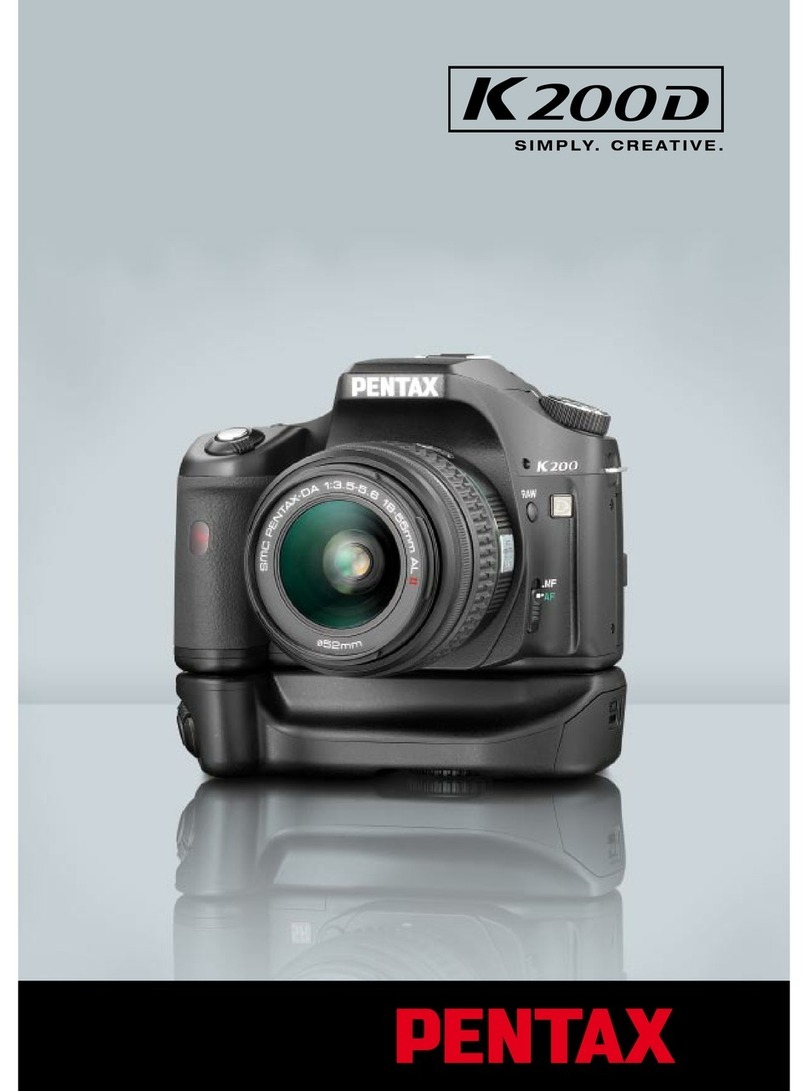
Pentax
Pentax 19554 Brochure & specs
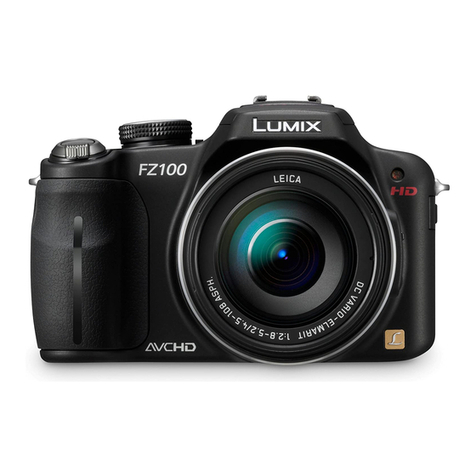
Panasonic
Panasonic LUMIX DMC-FZ100 operating instructions
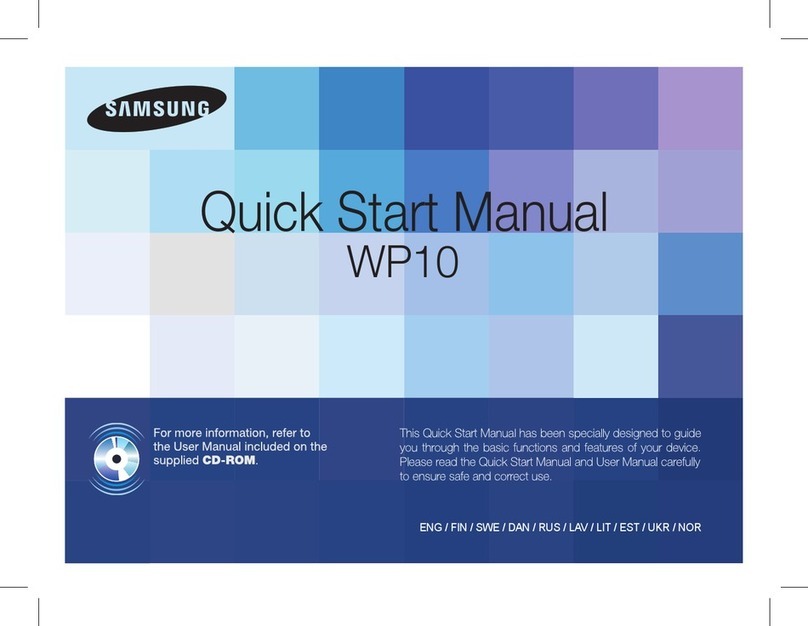
Samsung
Samsung SAMSUNG WP10 Quick start manual

Kodak
Kodak ZD710 - EASYSHARE Digital Camera user manual
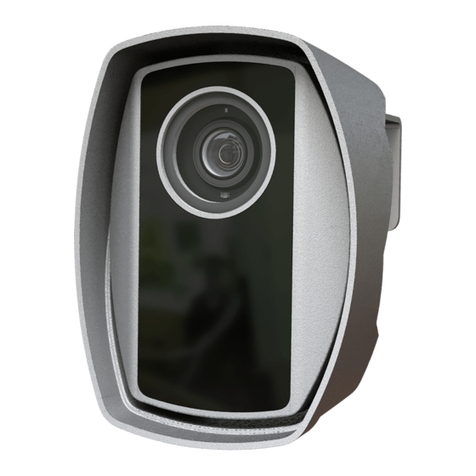
Adaptive Recognition
Adaptive Recognition Einar Quick install guide
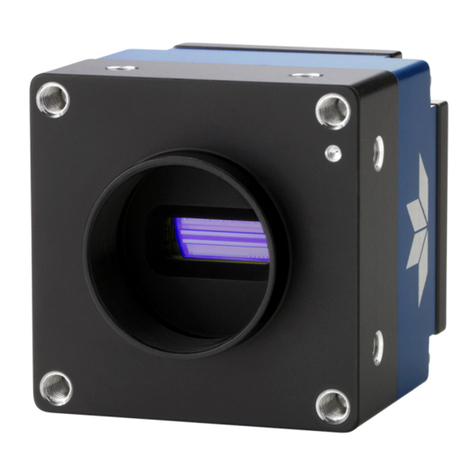
Dalsa
Dalsa Linea SWIR GigE Series user manual
